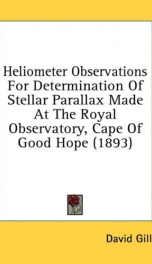heliometer observations for determination of stellar parallax made at the royal

HELIOMETER OBSERVATIONS FOR DETERMINATION OF STELLAR PARALLAX MADE AT THE ROYAL OBSERVATORY, CAPE OF GOOD HOPE - INTRODUCTION - Soon after I had the honour of being appointed Her Majestys Astronomer at the Cape, in 2879, I directed the attention of the Lords Commissioners of the Admiralty to the fact that no adequate equipment for refined extra meridian observations existed at the Observatory. Before making further official proposals-to remedy this defect I had the good fortune to procure, by private purchase, the Heliometer which I had used at Dun Echt, and in connexion with the expedition of Lord - Lindsay now the Earl of Crawford and Balcarres to the Island of Mauritius in 1874, when I observed with it the opposition of the minor planet Juno, and which I afterwards employed by Lord Lindsays kind permission, in the Royal Astronomical Societys expedition to the Island of Ascension to observe the opposition of Mars in 1877. t The instrument as employed at Mauritius and Ascension is fully described in the Dun Echt publications, Vol. 11. For use at the Cape I could not obtain the original equatoreal mounting, and therefore ordered a new stand for the Heliometer tube and cradle from Sir H. Grubb of Dublin, taking advantage of the opportunity thus offered to have some alteiations made on the instrument which previous experience had proved to be desirable. These alterations werechiefly in connexion with the slow motion of the tribe in position-angle. In the origihal instrument the quick motion in position-angle was accomplished by turning a rod, which carried a pinion which acted on a wheel of which the Heliometer tube formed the axis. Slow motion was given by rotating this rod very . slowly b mea of a toothed wheel acted on by a tangent screw, but the effect was to create a certain amount of tor ion of the rod before any rotation of the tube took place, so that there was wanting that immediate and precise response to the observers action khich is essential for easy and accurate measurement. I therefore planned the following arrangement. - At the end of the cradle next to the observer, there is fitted on the tube or rather on one of the collars attached to the tube Dun Echt publications, vol. ii. f Memoirs of the R. A. S., vol. xlvi., pp. 1-172. o 12309. wt. 1124. a 2 a ratchet wheel with square cut teeth. This wheel is so fitted as to turn smoothly on the collar, but, when the observer so desires, it can be clamped firmly to the tube by a handle coming do-wn to the eye-end. A steei screw with a square-cut thread such as Grubb uses for the driving screws of his Equatoreals acts on the teeth of this wheel, whilst the pivots of this screw rest in bushes in a frame attached to the cradle. The screw is turned by bevel wheels acted on by a handle coming down to the eye-end. When the observer turns the handle thewheel slowly rotates and, if the tube is1 clamped to the wheel, a smooth easy rotation is communicated to the tube. This slow motion as well as the Equatoreal mounting, and the driving clock were admirably constructed by Sir. H. Grubb ar d the instrument was in every respect efficient, stable, and convenient. During a visit to some of the principal European observatories, befo e my departure for the Cape, I met Mr. W. L. EIkin, a student under Professor Winnecke, who was then engaged in preparing his Inuz gwral Dissertation for the Degree of Doctor of Philosophy at the Universiby of Strasburg... --This text refers to the Paperback edition.
Info about the book
Author:
Series:
Unknown
ISBN:
0792363930
Rating:
5/5 (4)Your rating:
0/5
Languge:
English
Users who have this book
Users who want this book
What readers are saying
What do you think? Write your own comment on this book!
write a commentif you like heliometer observations for determination of stellar parallax made at the royal try:
Other books by this author
Do you want to exchange books? It’s EASY!
Get registered and find other users who want to give their favourite books to good hands!

